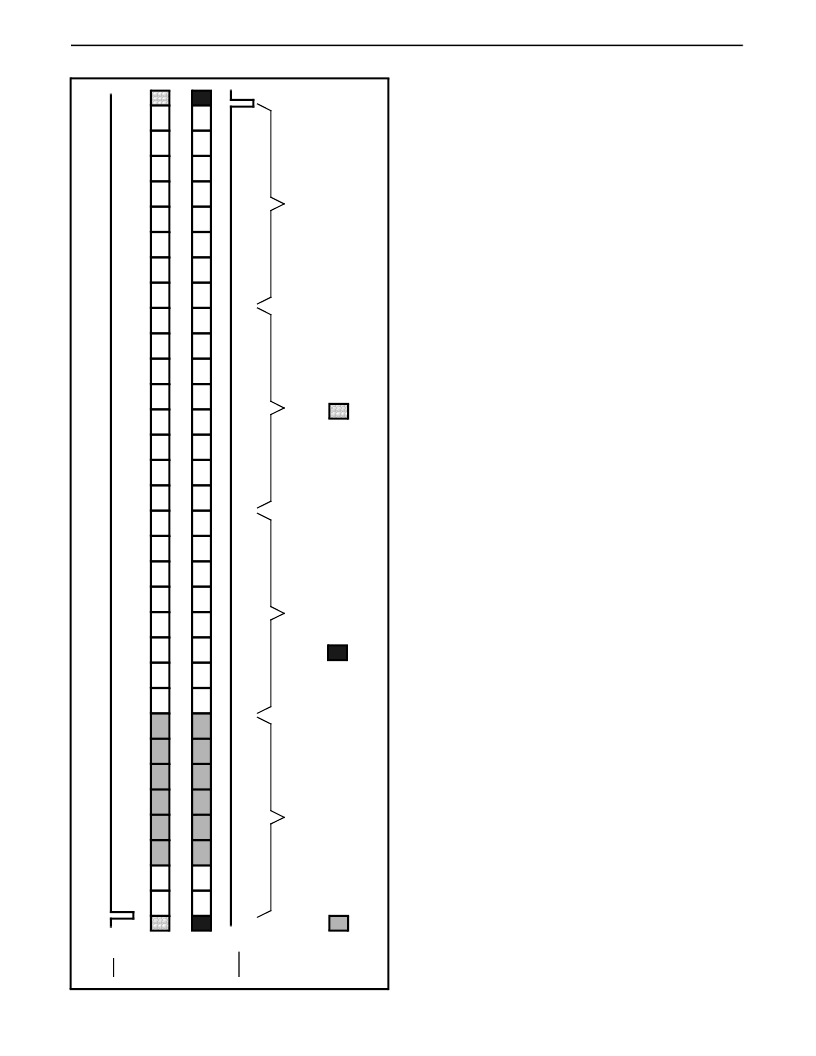- 您現(xiàn)在的位置:買賣IC網(wǎng) > PDF目錄359233 > MT8930CE (ZARLINK SEMICONDUCTOR INC) Subscriber Network Interface Circuit PDF資料下載
參數(shù)資料
| 型號(hào): | MT8930CE |
| 廠商: | ZARLINK SEMICONDUCTOR INC |
| 元件分類: | 數(shù)字傳輸電路 |
| 英文描述: | Subscriber Network Interface Circuit |
| 中文描述: | DATACOM, DIGITAL SLIC, PDIP28 |
| 封裝: | PLASTIC, MS-011AB, DIP-28 |
| 文件頁數(shù): | 6/41頁 |
| 文件大?。?/td> | 2516K |
| 代理商: | MT8930CE |
第1頁第2頁第3頁第4頁第5頁當(dāng)前第6頁第7頁第8頁第9頁第10頁第11頁第12頁第13頁第14頁第15頁第16頁第17頁第18頁第19頁第20頁第21頁第22頁第23頁第24頁第25頁第26頁第27頁第28頁第29頁第30頁第31頁第32頁第33頁第34頁第35頁第36頁第37頁第38頁第39頁第40頁第41頁

MT8930C
Data Sheet
6
Figure 4 - ST-BUS Channel Assignment
D
D
D
D
D
D
D
D
D
D
D
D
D
D
D
D
C
C
C
C
C
C
C
C
C
C
C
C
C
C
C
C
B
B
B
B
B
B
B
B
B
B
B
B
B
B
B
B
B
B
B
B
B
B
B
B
B
B
B
B
B
B
B
B
C
C
C
C
O
O
D
F
D
D
F
Intel microprocessor bus signals and timing. The
SNIC also has provisions for a controllerless mode
(Cmode=0), where the microprocessor port is
redefined to allow access to the control/status
registers via external hardware.
The three major blocks of the MT8930C, consisting
of the system serial interface (ST-BUS), HDLC
transceiver, and the digital subscriber loop interface
(S-interface) are interconnected by high speed data
busses. Data sent to and received from the
S-interface port (B1, B2 and D channels) can be
accessed from either the parallel microprocessor
port or the serial ST-BUS port. This is also true for
SNIC control and status information (C-channel).
Depacketized D-channel information to and from the
HDLC section can only be accessed through the
parallel microprocessor port.
S-Bus Interface
The S-Bus is a four wire, full duplex, time division
multiplexed transmission facility which exchanges
information at 192 kbit/s rate including two 64 kbit/s
PCM voice or data channels, a 16 kbit/s signalling
channel and 48 kbit/s for synchronization and
overhead. The relative position of these channels
with respect to the ST-BUS is shown in Figures 4
and 5.
The SNIC makes use of the first four channels on the
ST-BUS to transmit and receive control/status and
data to and from the S-interface port. These are the
B, D and C-channels (see Figure 4).
The B1 and B2 channels each have a bandwidth of
64 kbit/s and are used to carry PCM voice or data
across the network.
The D-channel is primarily intended to carry
signalling information for circuit switching through
the ISDN network. The SNIC provides the capability
of having a 16 kbit/s or full 64 kbit/s D-channel by
allocating the B1-channel timeslot to the D-channel.
Access to the depacketized D-channel is only
granted through the parallel microprocessor port.
The C-channel provides a means for the system to
control and monitor the functionality of the SNIC.
This control/status channel is accessed by the
system through the ST-BUS or microprocessor port.
The C-channel provides access to two registers
which provide complete control over the state
activation
machine,
the
mechanism as well as the various maintenance
functions. A detailed description of these registers is
discussed in the microprocessor port interface.
D-channel
priority
相關(guān)PDF資料 |
PDF描述 |
|---|---|
| MT8930CP | Subscriber Network Interface Circuit |
| MT8931C | Subscriber Network Interface Circuit |
| MT8931CE | Subscriber Network Interface Circuit |
| MT8931CP | Subscriber Network Interface Circuit |
| MT8931C-1 | CMOS ST-BUS⑩ FAMILY Subscriber Network Interface Circuit |
相關(guān)代理商/技術(shù)參數(shù) |
參數(shù)描述 |
|---|---|
| MT8930CP | 制造商:ZARLINK 制造商全稱:Zarlink Semiconductor Inc 功能描述:Subscriber Network Interface Circuit |
| MT8930CPR | 制造商:Microsemi Corporation 功能描述: |
| MT8931B | 制造商:MITEL 制造商全稱:Mitel Networks Corporation 功能描述:Subscriber Network Interface Circuit |
| MT8931BC | 制造商:MITEL 制造商全稱:Mitel Networks Corporation 功能描述:Subscriber Network Interface Circuit |
| MT8931BE | 制造商:MITEL 制造商全稱:Mitel Networks Corporation 功能描述:Subscriber Network Interface Circuit |
發(fā)布緊急采購,3分鐘左右您將得到回復(fù)。